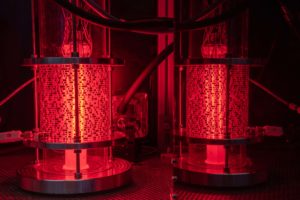Improve fertiliser production and ultimately the world’s food supply with sustainable ammonia synthesis. This and other long-term goals are being pursued by a new priority programme of the German Research Foundation on nitrogen conversion. One area of application is ammonia synthesis: this chemical is used in many indispensable products – including fertilisers. Researchers led by Professor Dirk Ziegenbalg from the University of Ulm were highly successful in the call for proposals: over the next three years, they will work on three of a total of eleven projects on sustainable and, above all, decentralised ammonia production.
Ammonia (NH3) is one of the most important basic chemicals. This compound of nitrogen and hydrogen is used to produce fertilisers, refrigerants and plastics, among other things. Ammonia can also be used as an energy and hydrogen carrier. Based on the so-called Haber-Bosch process, about 180 million tonnes of ammonia are produced synthetically every year. However, energy consumption and CO2 emissions are high: the process causes about one percent of annual greenhouse gas emissions worldwide. In addition, large and complex production facilities are needed.
In this context, the German Research Foundation (DFG) has selected eleven projects for a priority programme on sustainable nitrogen conversion. Over the next six years in total, the development of novel electrocatalytic, photocatalytic and photoelectrocatalytic alternatives that can break nitrogen triple bonds and replace the Haber-Bosch process will be advanced.
However, the priority programme is not limited to nitrogen reduction. Oxidative conversion processes, for example, are also in demand.
Researchers led by Professor Dirk Ziegenbalg from the Ulm Institute of Chemical Engineering were successful with no less than three projects. With various cooperation partners and equipped with around 1.6 million euros, they are contributing to the new Priority Programme 2370 “Nitroconversion”. The programme is coordinated by the University of Bayreuth (Professor Roland Marschall).
The overarching goal of the Ulm projects is climate-neutral ammonia synthesis: on the one hand, through the use of renewable energies and, on the other, through the holistic optimisation of the value chain. In addition, the production of the chemical is to become more efficient so that fertilisers can be produced according to demand and at low cost even in developing countries. In areas with nutrient-poor soils, this could increase crop yields and possibly avert famine. With this in mind, Professor Dirk Ziegenbalg is working with Professor Roland Marschall from the University of Bayreuth, which is leading the project, and the German Aerospace Centre (DLR) in Cologne to develop a process for light-driven ammonia production “on demand”. The researchers are developing a strategy to charge nanostructured semiconductors (TiO2 aerogels) with electrons through light irradiation and store them. Even in complete darkness, these semiconductors can be discharged with N2 to catalytically produce ammonia.
Furthermore, the researchers are working on a reactor concept to understand this form of ammonia production “on demand” in detail and ultimately to be able to carry it out decentrally. “Our reactor makes it possible to separate the different steps in ammonia production into light absorption and N2 reduction. This allows us to study and optimise each reaction step individually,” explains Professor Dirk Ziegenbalg. This reactor concept, which enables the intermediate storage of charged nanostructured materials, is another step on the way to efficient and decentralised chemical plants for the production of ammonia and ultimately fertilisers.
Alternative ways of ammonia production
In two other projects with Ulm participation, the researchers are examining further alternative concepts for ammonia production. Together with Professor Carsten Streb, who recently moved from Ulm University to Mainz, Professor Ziegenbalg is developing so-called flow-through photoreactors for decentralised ammonium nitrate production from nitrogen, water, sunlight and sustainable electricity. To master the challenges from the molecular to the reactor level, the chemists rely on novel concepts in material design, electrode production and reaction technology. The integration of the electrode into 3D-printed flow-through photoreactors allows the immediate adaptation of chemical as well as reaction technology requirements.
But photoelectrochemical nitrogen fixation is also an option for climate-neutral ammonia production. In the third project, theory, simulation and experiment go hand in hand. Professor Timo Jacob, head of the Ulm University Institute for Electrochemistry, wants to investigate the properties and photocatalytic activity of two novel copper-based, sunlight-absorbing oxide photocathodes with colleagues from Munich and Düsseldorf. “This project addresses two core topics of the priority programme at once: on the one hand, catalyst synthesis and physicochemical characterisation, and on the other hand, experimental and theoretical investigation of the reaction mechanism,” explains Professor Timo Jacob. Overall, the cooperation of the theoreticians and experimenters will contribute to identifying catalytically active surface structures for the photoelectrochemical nitrogen reduction reaction and provide clues to relevant reaction mechanisms.
As different as the approaches may be, they address several of the United Nations’ sustainability goals at different levels – including affordable and clean energy as well as climate protection measures.
Researchers from the Universities of Bayreuth and Mainz, the Technical University of Munich, the German Aerospace Centre in Cologne and the Max Planck Institute for Iron Research in Düsseldorf are involved in the three Ulm projects (2022-2025).
About DFG Priority Programmes
Priority Programmes of the Deutsche Forschungsgemeinschaft (DFG, German Research Foundation) deal with currently important research topics and serve the advancement of science. To this end, interregional and interdisciplinary researchers pool their expertise in individual projects. The funding is designed for six years – divided into two funding phases. https://www.dfg.de/foerderung/programme/koordinierte_programme/schwerpunktprogramme/index.html

